Abstract
We present an age-structured model for erythropoiesis in which the mortality of mature cells is described empirically by a physiologically realistic probability distribution of survival times. Under some assumptions, the model can be transformed into a system of delay differential equations with both constant and distributed delays. The stability of the equilibrium of this system and possible Hopf bifurcations are described for a number of probability distributions. Physiological motivation and interpretation of our results are provided.







Similar content being viewed by others
References
Arias CF (2017) How do red blood cells know when to die? R Soc Open Sci 4:160850
Bélair J, Campbell SA (1994) Stability and bifurcations of equilibria in a multiple-delayed differential equation. SIAM J Appl Math 54(5):1402–1424
Bélair J, Mackey MC, Mahaffy JM (1995) Age-structured and two delay models for erythropoiesis. Math Biosci 128:317–326
Brunner H, Makroglou A, Miller RK (1997) Mixed interpolation collocation methods for first and second order Volterra integro-differential equations with periodic solution. Appl Numer Math 23(4):381–402
Dankowicz H, Schilder F (2013) Recipes for continuation. In: Computational science & engineering, vol 11. Society for Industrial and Applied Mathematics (SIAM), Philadelphia
Eymard N, Bessonov N, Gandrillon O, Koury M, Volpert V (2015) The role of spatial organization of cells in erythropoiesis. J Math Biol 70:71–97
Foley C, Mackey MC (2009) Dynamic hematological disease: a review. J Math Biol 58(1–2):285–322
Kaestener L, Bogdanova A (2014) Regulation of red cell life-span, erythopoiesis, senescence, and clearance. Front Physiol 5:269. https://doi.org/10.3389/fphys.2014.00269
Kaushansky K, Lichtman M, Prchal J, Levi MM, Press OW (2015) Williams hematology 9E. McGrawHill, New York
Korell J, Coulter CV, Duffull SB (2011) A statistical model for red blood cell survival. J Theor Biol 268:39–49
Lang E, Qadri SM, Lang F (2012) Killing me softly—suicidal erythrocyte death. Int J Biochem Cell Biol 44:1236–1243
Mahaffy JM, Bélair J, Mackey MC (1998) Hematopoietic model with moving boundary condition and state dependent delay: application in erythropoiesis. J Theor Biol 190:135–146
Makroglou A, Kuang Y (2006) Some analytical and numerical results for a nonlinear volterra integro-differential equation with periodic solution modeling hematopoiesis. Hellen Eur Res Math Inf Sci 9:21–37
Shemin D, Rittenberg D (1946) The lifespan of the human red blood cell. J Biol Chem 166:627–636
Smith H (2011) An introduction to delay differential equations with applications to the life sciences. Texts in applied mathematics, vol 57. Springer, New York
Stépán G (1989) Retarded dynamical systems: stability and characteristic functions, vol 210. Pitman Research Notes in Mathematics Series. Longman Scientific & Technical, Harlow
Wazewska-Csyzewska M (1984) Erythrokinetics—radioisotopic methods of investigation and mathematical approach. US Department of Commerce National Technical Information Service
Funding
Partially supported by the Natural Sciences and Engineering Research Council of Canada (NSERC) as a Doctoral Scholarship to FPL and a Discovery Grant to JB.
Author information
Authors and Affiliations
Corresponding author
Additional information
Publisher's Note
Springer Nature remains neutral with regard to jurisdictional claims in published maps and institutional affiliations.
Appendix A: Numerical Methods
Appendix A: Numerical Methods
In this section, we briefly describe the numerical methods behind the result of Sect. 3.2, which is adapted from Brunner et al. (1997) and Makroglou and Kuang (2006). Our goal is to compute a numerical solution to the following integro-differential equation
on some finite time interval \(0 \le t \le t_f\) given any constant initial and past hormone level \(E(t) = E_0\), with \(t \le 0\). Now let us consider the equidistant mesh \(t_j = jh\) with \(j = 0,\dots ,N\) and \(h = t_f/N\), and let us furthermore suppose that the discrete maturation delay may be written as an integer multiple of the time-step as \(\mu _F = Lh, \, L \in {\mathbb {N}}\). Applying a second-order Runge–Kutta scheme alongside with trapezoidal integration yields a system of 2N equations given by
for the unknowns \((M_j,E_j)\), \(j = 1,\ldots ,N\). We remark that in Eq. (A.2), \(E_{i-L} = E_0\) if \(i \le L\) while the \(\alpha _i\) are the usual weights for trapezoidal quadrature defined by,
Fortunately, the presence of the discrete maturation delay makes it possible to explicitly solve the system A.2 given any constant initial and past hormone level \(E_0\).
Rights and permissions
About this article
Cite this article
Paquin-Lefebvre, F., Bélair, J. On the Effect of Age-Dependent Mortality on the Stability of a System of Delay-Differential Equations Modeling Erythropoiesis. Acta Biotheor 68, 5–19 (2020). https://doi.org/10.1007/s10441-019-09351-1
Received:
Accepted:
Published:
Issue Date:
DOI: https://doi.org/10.1007/s10441-019-09351-1




